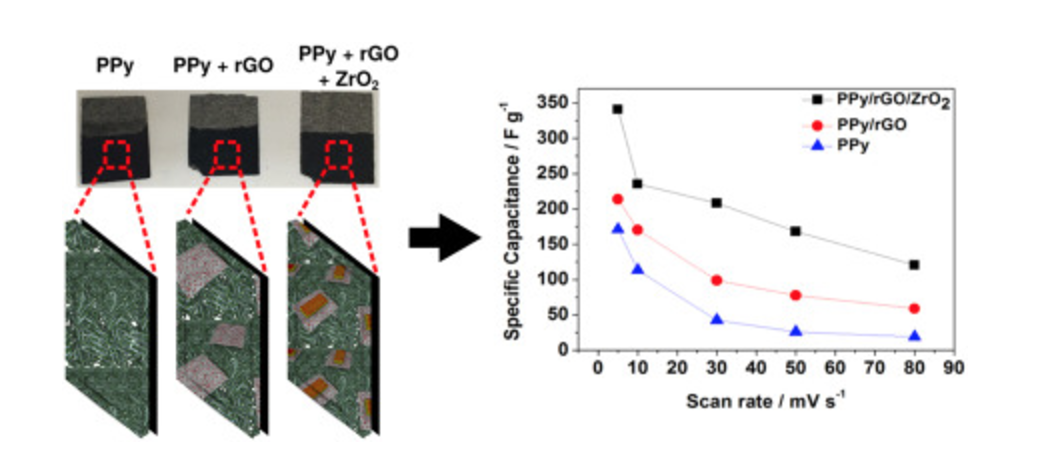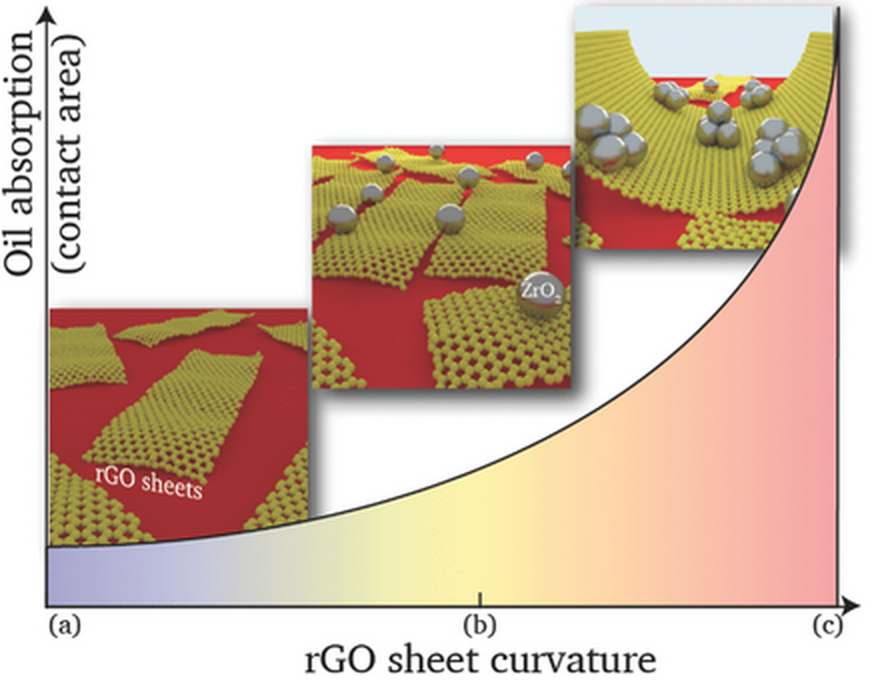Alves, Ana Paula P; Koizumi, Ryota; Samanta, Atanu; Machado, Leonardo D; Singh, Abhisek K; Galvao, Douglas S; Silva, Glaura G; Tiwary, Chandra S; Ajayan, Pulickel M
One-step electrodeposited 3D-ternary composite of zirconia nanoparticles, rGO and polypyrrole with enhanced supercapacitor performance Journal Article
In: Nano Energy, vol. 31, pp. 225-232, 2017.
@article{Alves2017,
title = {One-step electrodeposited 3D-ternary composite of zirconia nanoparticles, rGO and polypyrrole with enhanced supercapacitor performance},
author = {Alves, Ana Paula P and Koizumi, Ryota and Samanta, Atanu and Machado, Leonardo D and Singh, Abhisek K and Galvao, Douglas S and Silva, Glaura G and Tiwary, Chandra S and Ajayan, Pulickel M},
url = {http://www.sciencedirect.com/science/article/pii/S221128551630502X},
doi = {10.1016/j.nanoen.2016.11.018},
year = {2017},
date = {2017-01-01},
journal = {Nano Energy},
volume = {31},
pages = {225-232},
abstract = {Supercapacitor electrodes consisting of conjugated polymers (CP), metal oxides and graphene nanosheets have been explored as a strategy to achieve high specific capacitance, power, energy density, and stability. In this work, we synthesized a 3D structure composed of zirconia oxide nanoparticles (ZrO2), reduced graphene oxide (rGO) and polypyrrole (PPy), using a simple and easily scalable one-step chronopotentiometry method. Detailed characterization revealed that the addition of rGO and ZrO2 modified the morphology of the electrode material. The capacitance of the resulting architecture improved by up to a 100%. The ternary composite featured high stability, with an increase of 5% in capacitance after a thousand cycles. DFT and MD simulations were carried out in order to provide further insight on the role of zirconia.
},
keywords = {},
pubstate = {published},
tppubtype = {article}
}
Chandra Sekhar Tiwary Dibyendu Chakravarty, Leonardo Dantas Machado
Zirconia-Nanoparticle-Reinforced Morphology-Engineered Graphene-Based Foams Journal Article
In: Advanced Materials, vol. 27, no. 31, pp. 4534–4543, 2015.
@article{Chakravarty2015,
title = {Zirconia-Nanoparticle-Reinforced Morphology-Engineered Graphene-Based Foams},
author = { Dibyendu Chakravarty , Chandra Sekhar Tiwary , Leonardo Dantas Machado ,
Gustavo Brunetto , Soumya Vinod , Ram Manohar Yadav , Douglas S. Galvao ,
Shrikant V. Joshi , Govindan Sundararajan, Pulickel M. Ajayan },
url = {http://onlinelibrary.wiley.com/doi/10.1002/adma.201502409/full},
doi = {10.1002/adma.201502409},
year = {2015},
date = {2015-07-15},
journal = {Advanced Materials},
volume = {27},
number = {31},
pages = {4534–4543},
abstract = {The morphology of graphene-based foams can be engineered by reinforcing them with nanocrystalline zirconia, thus improving their oil-adsorption capacity; This can be observed experimentally and explained theoretically. Low zirconia fractions yield flaky microstructures where zirconia nanoparticles arrest propagating cracks. Higher zirconia concentrations possess a mesh-like interconnected structure where the degree of coiling is dependant on the local zirconia content.},
keywords = {},
pubstate = {published},
tppubtype = {article}
}
2017

Alves, Ana Paula P; Koizumi, Ryota; Samanta, Atanu; Machado, Leonardo D; Singh, Abhisek K; Galvao, Douglas S; Silva, Glaura G; Tiwary, Chandra S; Ajayan, Pulickel M
One-step electrodeposited 3D-ternary composite of zirconia nanoparticles, rGO and polypyrrole with enhanced supercapacitor performance Journal Article
In: Nano Energy, vol. 31, pp. 225-232, 2017.
Abstract | Links | BibTeX | Tags: Molecular Dynamics, Polymers, supercapacitors, Zirconia
@article{Alves2017,
title = {One-step electrodeposited 3D-ternary composite of zirconia nanoparticles, rGO and polypyrrole with enhanced supercapacitor performance},
author = {Alves, Ana Paula P and Koizumi, Ryota and Samanta, Atanu and Machado, Leonardo D and Singh, Abhisek K and Galvao, Douglas S and Silva, Glaura G and Tiwary, Chandra S and Ajayan, Pulickel M},
url = {http://www.sciencedirect.com/science/article/pii/S221128551630502X},
doi = {10.1016/j.nanoen.2016.11.018},
year = {2017},
date = {2017-01-01},
journal = {Nano Energy},
volume = {31},
pages = {225-232},
abstract = {Supercapacitor electrodes consisting of conjugated polymers (CP), metal oxides and graphene nanosheets have been explored as a strategy to achieve high specific capacitance, power, energy density, and stability. In this work, we synthesized a 3D structure composed of zirconia oxide nanoparticles (ZrO2), reduced graphene oxide (rGO) and polypyrrole (PPy), using a simple and easily scalable one-step chronopotentiometry method. Detailed characterization revealed that the addition of rGO and ZrO2 modified the morphology of the electrode material. The capacitance of the resulting architecture improved by up to a 100%. The ternary composite featured high stability, with an increase of 5% in capacitance after a thousand cycles. DFT and MD simulations were carried out in order to provide further insight on the role of zirconia.
},
keywords = {Molecular Dynamics, Polymers, supercapacitors, Zirconia},
pubstate = {published},
tppubtype = {article}
}
2015

Chandra Sekhar Tiwary Dibyendu Chakravarty, Leonardo Dantas Machado
Zirconia-Nanoparticle-Reinforced Morphology-Engineered Graphene-Based Foams Journal Article
In: Advanced Materials, vol. 27, no. 31, pp. 4534–4543, 2015.
Abstract | Links | BibTeX | Tags: Electronic Structure, Mechanical Properties, Mole, Molecular Dynamics, Nanoparticles, Zirconia
@article{Chakravarty2015,
title = {Zirconia-Nanoparticle-Reinforced Morphology-Engineered Graphene-Based Foams},
author = { Dibyendu Chakravarty , Chandra Sekhar Tiwary , Leonardo Dantas Machado ,
Gustavo Brunetto , Soumya Vinod , Ram Manohar Yadav , Douglas S. Galvao ,
Shrikant V. Joshi , Govindan Sundararajan, Pulickel M. Ajayan },
url = {http://onlinelibrary.wiley.com/doi/10.1002/adma.201502409/full},
doi = {10.1002/adma.201502409},
year = {2015},
date = {2015-07-15},
journal = {Advanced Materials},
volume = {27},
number = {31},
pages = {4534–4543},
abstract = {The morphology of graphene-based foams can be engineered by reinforcing them with nanocrystalline zirconia, thus improving their oil-adsorption capacity; This can be observed experimentally and explained theoretically. Low zirconia fractions yield flaky microstructures where zirconia nanoparticles arrest propagating cracks. Higher zirconia concentrations possess a mesh-like interconnected structure where the degree of coiling is dependant on the local zirconia content.},
keywords = {Electronic Structure, Mechanical Properties, Mole, Molecular Dynamics, Nanoparticles, Zirconia},
pubstate = {published},
tppubtype = {article}
}
http://scholar.google.com/citations?hl=en&user=95SvbM8AAAAJ


